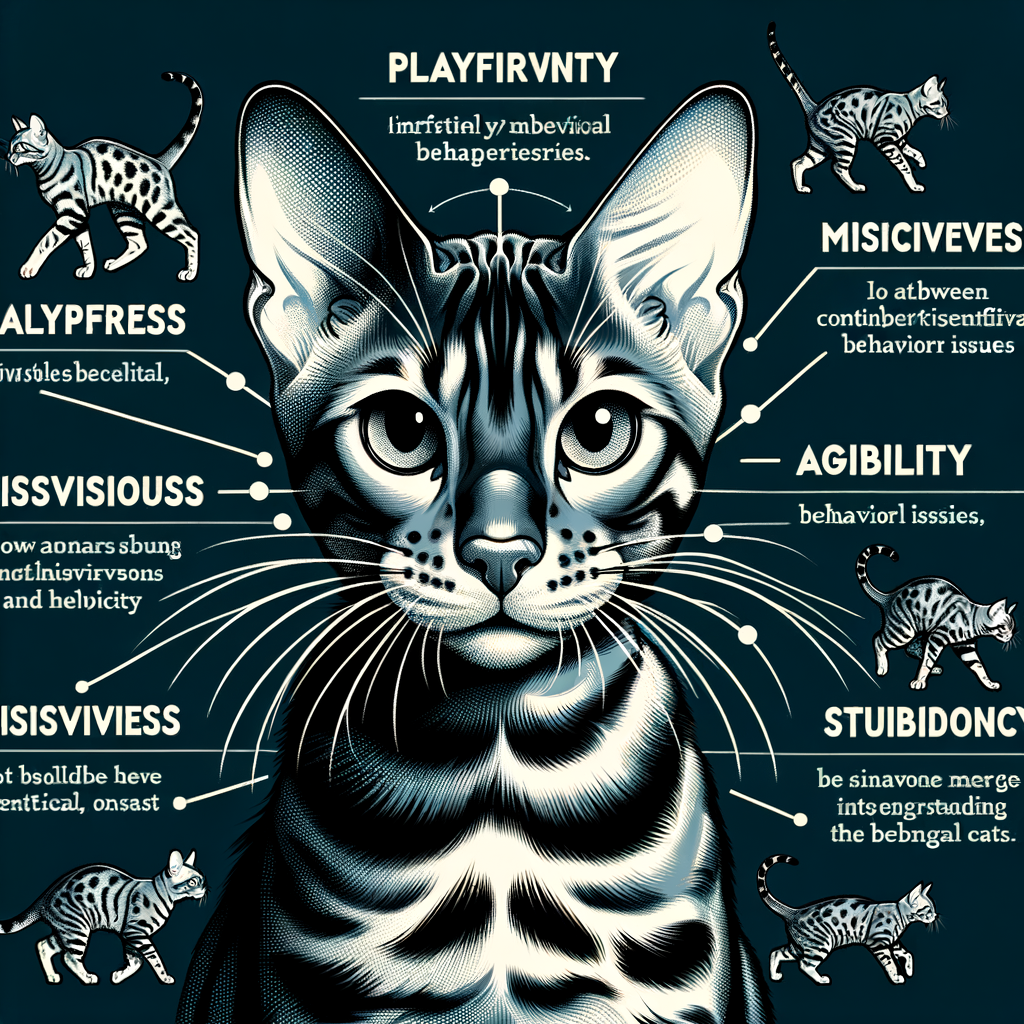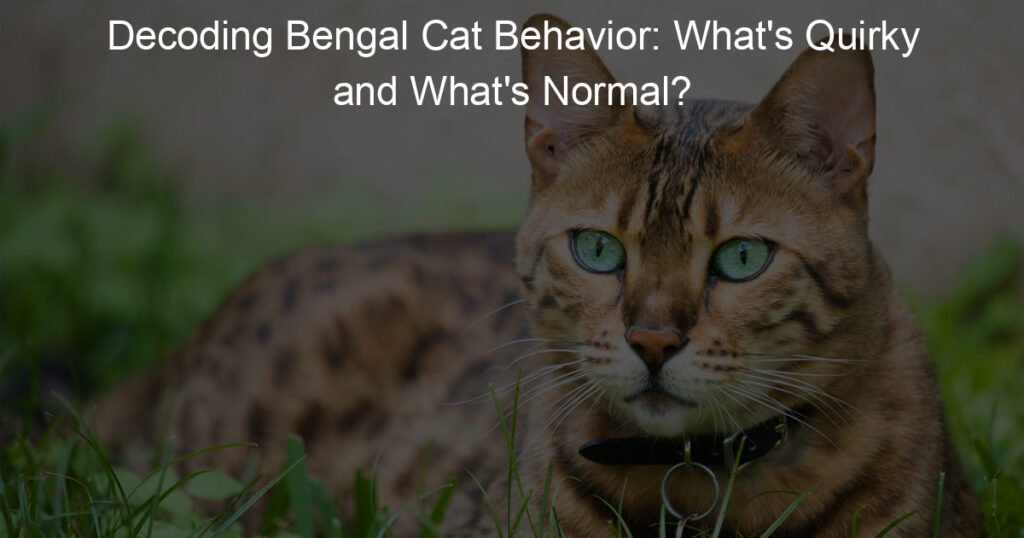
Introduction to Bengal Cat Traits
When it comes to cats, the Bengal breed stands out with its unique traits and captivating personality. In this section, we will delve into the fascinating world of Bengal cats, exploring what makes them so special and different from other cat breeds.
Originating from the crossbreeding of domestic cats and Asian leopard cats, Bengal cats are known for their wild appearance and playful nature. They are highly active and love to explore their surroundings, often displaying a level of curiosity that is unmatched by other breeds. Their distinctive coat, which can range from golden to silver and is marked with spots or marbled patterns, adds to their exotic charm.
Bengal cats are not just about their stunning looks. They are intelligent, agile, and sociable animals. They enjoy interactive games and have a strong affinity for water, which is quite unusual for cats. Bengal cats are also known for their vocalization; they have a wide range of vocal sounds that they use to communicate their needs and emotions. Furthermore, their strong hunting instincts make them excellent hunters, even if they are indoor pets.
In the following sections, we will delve deeper into the behavior of Bengal cats, understand common behavior issues, and learn from real-life case studies. By the end of this article, you will have a comprehensive understanding of your Bengal cat’s quirks and norms, helping you build a stronger bond with your feline friend.
Understanding Bengal Cat Behavior
When it comes to understanding Bengal cat behavior, it’s important to know that these cats are unique in their own ways. They have certain traits and habits that set them apart from other breeds. Let’s delve into the normal behavior of Bengal cats.
Normal Behavior of Bengal Cats
Bengal cats exhibit a range of behaviors that are considered normal for their breed. These behaviors can be categorized into three main areas: playfulness, love for water, and vocalization.
-
- Typical Bengal Cat Behavior: Playfulness
Bengal cats are known for their playful nature. They are full of energy and love to play games. Whether it’s chasing a toy mouse or pouncing on a piece of string, their playful behavior is a joy to watch. This playfulness is not only a source of entertainment for them but also a way for them to exercise and stay fit.
-
- Bengal Cat Normal Habits: Love for Water
Unlike most cats, Bengal cats have a fascination with water. They are often found playing in water bowls, faucets, or even the bathtub. This love for water can be traced back to their wild ancestry, as their ancestors were known to swim in search of prey.
-
- Bengal Cat Behavior Patterns: Vocalization
Bengal cats are quite vocal and have a wide range of sounds. They use these sounds to communicate their needs and feelings. Whether they’re hungry, want attention, or are just feeling chatty, their vocalization is a key part of their behavior.
In conclusion, understanding the normal behavior of Bengal cats can help you better care for your pet. Remember, their playfulness, love for water, and vocalization are all part of what makes them unique. Embrace these behaviors and enjoy the companionship of your Bengal cat.
Bengal Cat Personality
When it comes to understanding the behavior of Bengal cats, their unique personality traits play a significant role. These cats are known for their distinct characteristics, which set them apart from other breeds. Let’s delve into the three main aspects of a Bengal cat’s personality:
- Intelligence and Curiosity
Bengal cats are highly intelligent and curious creatures. They are always on the lookout for new things to explore and learn. This trait makes them quick learners who can easily adapt to new environments and situations. Their curious nature often leads them to investigate every corner of their surroundings, making them excellent problem solvers.
- Active and Playful Nature
Bengal cats are known for their active and playful nature. They love to engage in physical activities and games. Unlike some other cat breeds, Bengals are not the type to laze around all day. They require regular exercise and mental stimulation to keep them happy and healthy. Their playful nature makes them a great companion for families with children.
- Affectionate but Not Overly Dependent
While Bengal cats are affectionate and enjoy the company of their human companions, they are not overly dependent. They value their independence and can spend time on their own without feeling lonely. This balance between affection and independence makes them an ideal pet for those who want a loving companion but also value their personal space.
In conclusion, understanding these personality traits can help you build a stronger bond with your Bengal cat. Remember, every cat is unique, and these traits can vary from one Bengal cat to another. However, these general traits provide a good starting point for understanding the behavior of this fascinating breed.
Bengal Cat Behavior Issues
Understanding the behavior of your Bengal cat is crucial to maintaining a harmonious relationship with your feline friend. However, like any other breed, Bengal cats can exhibit certain behavior issues. Let’s delve into some of the common problems you might encounter.
Common Bengal Cat Behavior Problems
Bengal cats are known for their unique personalities, but they can sometimes exhibit behaviors that may be concerning. Here are some common issues:
-
- Aggression: Bengal cats are naturally active and playful. However, sometimes this playfulness can turn into aggression. This could be due to various reasons like fear, territorial issues, or lack of socialization. It’s important to understand that aggression is not a natural state for any cat, and it often indicates an underlying issue that needs to be addressed.
-
- Excessive Vocalization: Bengal cats are quite vocal and communicate through their meows. However, excessive vocalization could be a sign of distress or discomfort. It could be due to hunger, loneliness, or even a health issue. If your Bengal cat is meowing more than usual, it’s important to find out why.
- Separation Anxiety: Bengal cats are known for their strong bonds with their human companions. They crave attention and interaction. When left alone for long periods, they can develop separation anxiety. This can lead to destructive behavior, excessive meowing, or even refusal to eat.
Remember, understanding your Bengal cat’s behavior is the first step in addressing any issues. It’s always best to consult with a vet or a professional cat behaviorist if you’re unsure about your cat’s behavior.
Addressing Bengal Cat Behavior Problems
When it comes to Bengal cat behavior problems, it’s essential to approach them with patience and understanding. Here are three key steps to address these issues effectively:
- Understanding the Root Cause
Every behavior has a reason behind it. It’s crucial to understand the root cause of your Bengal cat’s behavior problem. For instance, aggression might be a result of fear or territorial instincts, while excessive vocalization could be a sign of loneliness or boredom. By identifying the underlying cause, you can address the problem more effectively.
- Proper Training and Socialization
Training and socialization play a significant role in shaping a Bengal cat’s behavior. Start training your Bengal cat from a young age. Use positive reinforcement techniques like treats, praises, or petting to encourage good behavior. Socialization helps your cat get used to different environments, people, and other pets. This can help reduce behavior problems like aggression and separation anxiety.
- Seeking Professional Help When Necessary
If your Bengal cat’s behavior problem persists despite your best efforts, it might be time to seek professional help. A professional cat behaviorist or a veterinarian can provide valuable insights into your cat’s behavior and suggest effective strategies for improvement. Remember, there’s no shame in seeking help. It shows your commitment to providing the best care for your Bengal cat.
In conclusion, addressing Bengal cat behavior problems requires understanding, patience, and sometimes professional help. But with the right approach, you can help your Bengal cat overcome these issues and lead a happy, healthy life.
Case Studies: Bengal Cat Behavior
Understanding the behavior of Bengal cats can be a challenging task. However, through real-life case studies, we can gain a better understanding of their unique traits and how to manage them. Let’s delve into two specific cases that highlight common behavioral issues in Bengal cats: aggression and separation anxiety.
-
- Case Study 1: Addressing Aggression in a Bengal Cat
Meet Max, a two-year-old Bengal cat known for his aggressive behavior. His owners were concerned as he often swiped at them with his claws. They decided to consult a feline behaviorist to help manage Max’s aggression.
The behaviorist suggested that Max’s aggression might be due to a lack of mental stimulation. Bengals are known for their high energy levels and intellectual curiosity. When these needs aren’t met, they can become frustrated and act out.
Max’s owners introduced interactive toys and puzzle feeders into his daily routine. They also ensured he had plenty of playtime. Over time, Max’s aggressive behavior significantly reduced. This case study highlights the importance of mental stimulation in managing aggression in Bengal cats.
-
- Case Study 2: Dealing with Separation Anxiety in a Bengal Cat
Next, we have Bella, a Bengal cat who suffered from separation anxiety. Whenever her owners left the house, Bella would meow excessively and even refuse to eat.
Separation anxiety in cats can often be traced back to sudden changes in their environment or routine. Bella’s owners had recently moved, and this change seemed to trigger her anxiety.
To help Bella cope, her owners started leaving her alone for short periods, gradually increasing the time. They also left out toys and treats to keep her occupied. Over time, Bella became more comfortable being alone. This case study shows that patience and gradual exposure can help manage separation anxiety in Bengal cats.
These case studies offer valuable insights into Bengal cat behavior and how to manage it. Remember, every cat is unique, and what works for one might not work for another. It’s crucial to understand your Bengal’s individual needs and behaviors to ensure they lead a happy and healthy life.
Key Takeaways: Understanding Your Bengal Cat
As we conclude our exploration of Bengal cats, let’s summarize the most important points to remember. These key takeaways will help you understand and appreciate your Bengal cat’s unique personality, address any behavior issues effectively, and enjoy a fulfilling relationship with your feline friend.
-
- Recognizing and appreciating the unique Bengal cat personality
Bengal cats are known for their playful, energetic, and intelligent nature. They are not your average house cats. They love to explore, climb, and even play fetch. They are also very vocal and will communicate their needs and desires to you. Understanding these traits is the first step towards appreciating your Bengal cat’s unique personality.
-
- Addressing behavior issues effectively
Like any other breed, Bengal cats can exhibit behavior issues. These can range from excessive vocalization to destructive behavior. Addressing these issues requires patience, understanding, and consistency. Remember, punishment doesn’t work with cats. Instead, use positive reinforcement techniques to encourage good behavior.
-
- Enjoying a fulfilling relationship with your Bengal cat
Understanding and appreciating your Bengal cat’s unique personality, coupled with effectively addressing any behavior issues, will pave the way for a fulfilling relationship with your cat. Spend quality time with your Bengal cat, engage them in stimulating activities, and provide them with plenty of love and care. This will not only keep your cat happy but also strengthen your bond with them.
In conclusion, Bengal cats are a unique breed with distinct traits and behaviors. Understanding these will help you form a strong, loving, and fulfilling relationship with your Bengal cat. Remember, every cat is unique. So, take the time to understand your Bengal cat and appreciate them for who they are.
Conclusion: Embracing the Quirks and Norms of Bengal Cat Behavior
As we reach the end of our journey into the world of Bengal cats, it’s clear that these felines are a unique breed with their own set of quirks and norms. Understanding and accepting these behaviors is not only crucial for their well-being, but also for building a strong bond with your furry friend.
-
- Understanding and accepting the unique behavior characteristics of Bengal cats
Bengal cats are known for their playful and active nature. They love to explore, climb, and even swim, which is quite unusual for a cat. They are also highly intelligent and need mental stimulation to prevent boredom. These traits can sometimes be challenging for pet owners, but they are part of what makes Bengal cats so special.
Remember, each Bengal cat is unique. Some may be more active or vocal than others. It’s essential to observe and understand your cat’s individual behavior to provide the best care possible.
-
- Building a strong bond with your Bengal cat
Building a strong bond with your Bengal cat requires time, patience, and understanding. Engage with them through play and training sessions. This not only provides the mental and physical stimulation they need but also strengthens your relationship.
Remember to respect their space and independence. Just like us, cats also need their alone time. Provide them with a safe and comfortable space where they can retreat when they want to.
Lastly, communicate with your Bengal cat. They are very vocal and use various sounds to express their feelings. Responding to their calls and understanding their body language can significantly improve your bond.
In conclusion, embracing the quirks and norms of Bengal cat behavior is all about understanding and accepting these unique creatures for who they are. It’s about building a strong bond based on respect, patience, and love. After all, the joy and companionship that a Bengal cat brings to our lives is worth every bit of effort.














